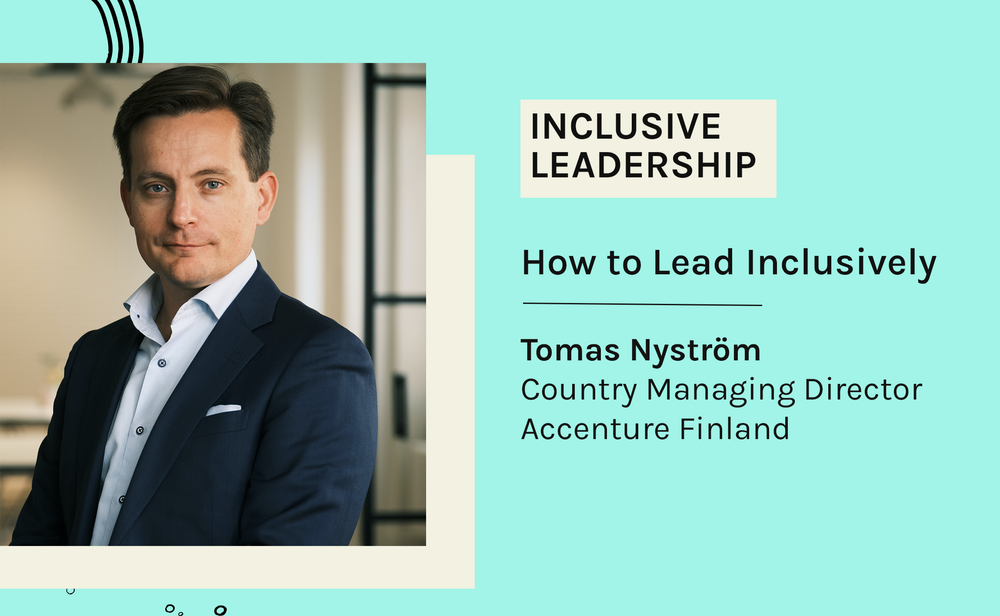Inklusiiv talked to Tomas Nyström about D&I learnings, processes and how Accenture approaches and advances inclusive leadership internally. The interview is part of a new Inklusiiv Leadership Blog Series which aims to share learnings, insights and different viewpoints about advancing D&I in organizations from a practical point of view from different business leaders.
Accenture has a long history of pursuing D&I through research and company strategy.

Tomas Nyström, Accenture Finland’s Country Managing Director, guides 1,000+ employees and leads conversation about the importance of D&I, internally and externally on a regular basis.
Studies published by Accenture prove that committing to D&I fosters innovation, business profitability and helps attract talent. Making sure the company walks the talk, Accenture has strict metrics in place on how they measure D&I goals as an organization.
We discussed with Tomas about:
- What generally hinders D&I at work
- Examples of action-based D&I
- How to be accountable for D&I as a leader
- How do you drive change in D&I
I: When did you learn about the importance of Diversity & Inclusion (D&I)?
T: Accenture has a long history in the area of D&I. For instance, for as long as I can remember (and I have worked over 23 years at the company) – we have had an active global LGBT+ community and in Finland the local network was established 7 years ago. For me, D&I policies make strong business sense. Therefore, investing into D&I strategy is not only a decent thing to do but also is good for business.
I: What does Diversity and Inclusion mean to you as a business leader?
T: Diversity is more straightforward to understand – even though the dimensions of diversity keep expanding. Diversity can be tied into numbers and figures. Inclusion, on the other hand, is more related to behaviours that support diversity and that’s why it impacts everyone. Inclusion is based on how we treat individuals regardless of who they are. Understanding inclusion takes time.
I: How does Accenture Finland approach D&I?
T: We do bias training and teach everyone at Accenture Finland that from a biological standpoint we as human beings sometimes take cognitive shortcuts. We need to be aware of these cognitive shortcuts and combat them.
There is a lot of work to be done making biases visible and creating awareness around them. We have lots of programs and networks – for example, mental health, women, cross-cultural, LGBT+ and family networks – where individuals can discuss different topics and support each other.
I: Inclusion is often described as taking actions. Can you share examples of actions Accenture has taken to advance inclusion?
T: When researching action-based inclusion, we found over 40 different actions you can take.
One step we have taken, for example, is to create a network for connection. We have found that creating connections is important, particularly for people within the company who, for one reason or another, have had to take leave of absence (for example, parental leave or study leave). These networks help getting back to work, which can be challenging, after a break.
I: What is the main challenge that hinders progress in companies embracing D&I?
T: One challenge is that people don’t understand the importance of D&I, until they experience it or hear a story about someone experiencing biases first-hand or have been treated unfairly in a situation.
Another challenge is that many leaders think that they are further ahead with building an inclusive culture than what is perceived by the employees. According to Accenture research 68 percent of leaders feel they create empowering environments but just 36 percent of employees agree. So, there is still plenty of work to be done.
According to Accenture research 68 percent of leaders feel they create empowering environments but just 36 percent of employees agree.
I: Do you have principles that allow you to practice inclusive leadership?
T: I like to be transparent, open and detail-oriented as a leader. Corporate strategy cannot be a secret strategy, you need to communicate it to everybody, you need to be very clear with everyone about what we are doing and why. An example from our company: Strategically speaking, cloud technology is an important theme for us as an organisation. Therefore, we encourage each and everyone, despite their position in the company, to do a course or module in order to certify in cloud technology.
I: How do you hold yourself accountable to employees and the board about D&I?
T: We have strict metrics in place. To make the right decisions we need the data. We track diversity metrics in recruiting, promotions and also the people who leave us. We also have goals related to D&I. For example, globally Accenture’s goal is to be a totally gender-balanced workplace by 2025.
I: How do you drive change in D&I?
T: I believe that leadership should run by example and that’s why I spend time promoting D&I and talking about it internally and externally. I like to voice out my beliefs, encourage others to do the same and thus hoping we create a chain reaction. Role models are also very important and here at Accenture we aim to support, grow and promote, for example, the great women leaders we have.
Do you want to learn more about best practices from Accenture or get more insights on inclusive leadership? Take a look at Accenture’s latest Getting to Equal reports from 2020 and 2019.
Another good source of information is Harvard Business Review’s article on specific actions leaders can take to practice inclusive leadership or Inklusiiv’s resource bank.
This was our first blog in Inklusiiv Leadership series. If you have any suggestions which business leaders you would like to see interviewed on this series or what areas you would like to learn about, contact us at hello@inklusiiv.org

